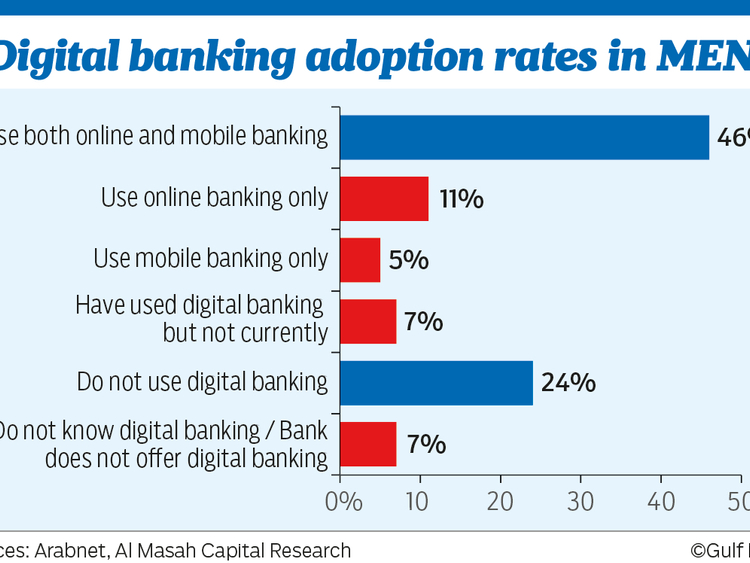Dubai: The Middle East and North Africa (Mena) region offers promising opportunities for the banks and other financial institutions for digital adoption as the regions is fast catching up in technology adoption, according to industry experts.
Over the past few years, the Mena has closed the digital gap with North America, Europe, and Asia through investments in telecom infrastructure, digital readiness initiatives, and competitive arrangements for network providers. Despite rising investments, according to a recent McKinsey report, the digital economy accounts only 4.1 per cent of Mena’s GDP across sectors, which is just 50 per cent of that in the US. Additionally, there is considerable variance in the regional economies with the GCC nations accounting for a higher share in digitisation than their neighbours.
According to McKinsey, the region has realised only 8 per cent of its digital potential, led by GCC nations — UAE (16.4 per cent), Qatar (14.9 per cent), Bahrain (13.6 per cent), and Saudi Arabia (11.5 per cent). On a comparative note, Western Europe has achieved an estimated 15 per cent of its digital potential, while the US economy has captured 18 per cent. This signifies the huge potential in the region to disrupt digitisation initiatives for advancements as part of the ambitious diversification strategies and long-term economic visions.
According to a recent research by Al Masah Capital, the Mena region enjoys a large millennial population, which is expected to further drive the future of digital banking industry.
Consumer engagement
With cost reduction through digitisation as the main focus for regional banks, major players are now creating ecosystems that will ultimately offer customers multiple interaction-points such as the branch, ATM, online presence (e-banking) and mobile banking apps.
“The Middle East, being no exception to the global trend, is now on the verge of a massive digital disruption. Businesses and governments are now alive to the fact that in order to optimise operating costs and resources, guarantee customer satisfaction, attract new customers, and gain competitive advantage, digital adoption is a must.” said Shailesh Dash, chief executive officer of Al Masah Capital.
Mobile and online banking
The region is witnessing an extensive usage of digital customer engagement channels such as websites, social media platforms, apps, and digital transactions. With over 90 per cent of the mobile users in the Mena region owning smart devices, mobile banking has now become a significant component of the banking strategy. The high mobile banking penetration in the region is attributed to its cost-effectiveness and its time-saving method of conducting business, which frees customers of the task of physically visiting the banking halls.
With Mena’s banking industry changing rapidly, digital technologies have now opened up new revenue streams for the financial sector.
Traditional brick and mortar presence is now under imminent threat with technology, automation, and big data now on the verge of making branches almost obsolete.
This, according to Shailesh, is expected to gather momentum as banks across the region respond with a greater focus on mobile banking, smart branches, and social media banking.
“Digital technologies haven now opened up new revenue streams for banks and financial institutions. And with banks now serving a new crop of digitally-savvy customers, it is evident that these institutions are now pegging their profitability to cost-effective digital solutions.” noted Shailesh.
Fintech scene
The Fintech trend is yet to fully catch up in Mena even as this digital revolution continues to engulf other developed financial sectors globally. Despite its infancy in the region, this new trend is still expected to offer Mena players significant opportunities to capitalise on. In the last ten years, the regional governments have sunk over $100 million, opened Fintech accelerators, and also introduced new regulations to promote digital banking.
Even as regional countries undergo a significant transformation phase in the digital banking arena, penetration still remains relatively low in the region due to a lack of awareness.
Regional players continue to face numerous challenges in the adoption of digital trends, some of which include, low adoption rate, integration of complex services with digital space, low availability of digital infrastructure, and data security especially in the wake of rising cyber-attacks.













